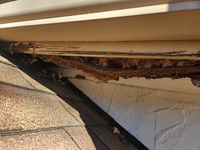Anyone here into woodworking and/or carpentry? Whether its for construction/home improvement purposes, making furniture, or anything else? Just getting into it myself, and I'm amazed at the level of knowledge and skill displayed by people who have mastered these trades.
Next week I'll be doing some soffit repair/rehab on a house that is owned by a widow, who has fallen behind on upkeep and maintenance:

Ideally you'd want a full soffit and fascia replacement, but this person cannot afford to pay a roofing contractor 10 grand, so I'm going to patch the rotted areas with fresh wood and sandable wood filler, and re-fasten anything that's sagging but still usable and finish it off by caulking the seams and a using primer coat so it's at least weather proof and ready for painting. To add to the "fun" it's a 2 story house and my first time attempting a project like this.
For tools I've got a sliding 12" double bevel miter saw, a cordless 6 1/2" circular saw, and a cordless oscillating multi-tool for cutting and sanding, and cordless impact and drill drivers for fasteners.
Will update with more pictures after work is done. Any tips, tricks, nuggets of wisdom appreciated.
Next week I'll be doing some soffit repair/rehab on a house that is owned by a widow, who has fallen behind on upkeep and maintenance:

Ideally you'd want a full soffit and fascia replacement, but this person cannot afford to pay a roofing contractor 10 grand, so I'm going to patch the rotted areas with fresh wood and sandable wood filler, and re-fasten anything that's sagging but still usable and finish it off by caulking the seams and a using primer coat so it's at least weather proof and ready for painting. To add to the "fun" it's a 2 story house and my first time attempting a project like this.
For tools I've got a sliding 12" double bevel miter saw, a cordless 6 1/2" circular saw, and a cordless oscillating multi-tool for cutting and sanding, and cordless impact and drill drivers for fasteners.
Will update with more pictures after work is done. Any tips, tricks, nuggets of wisdom appreciated.
